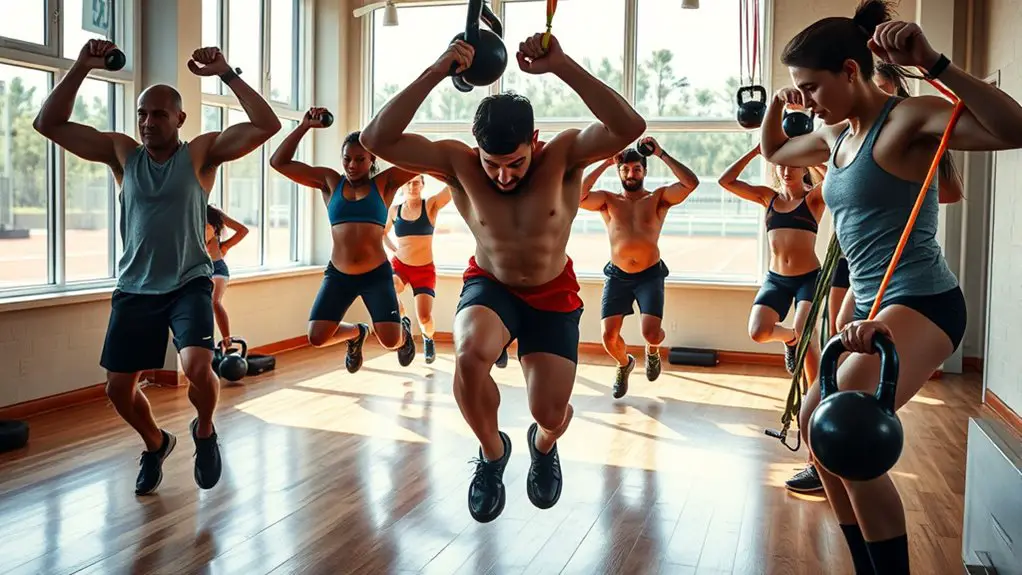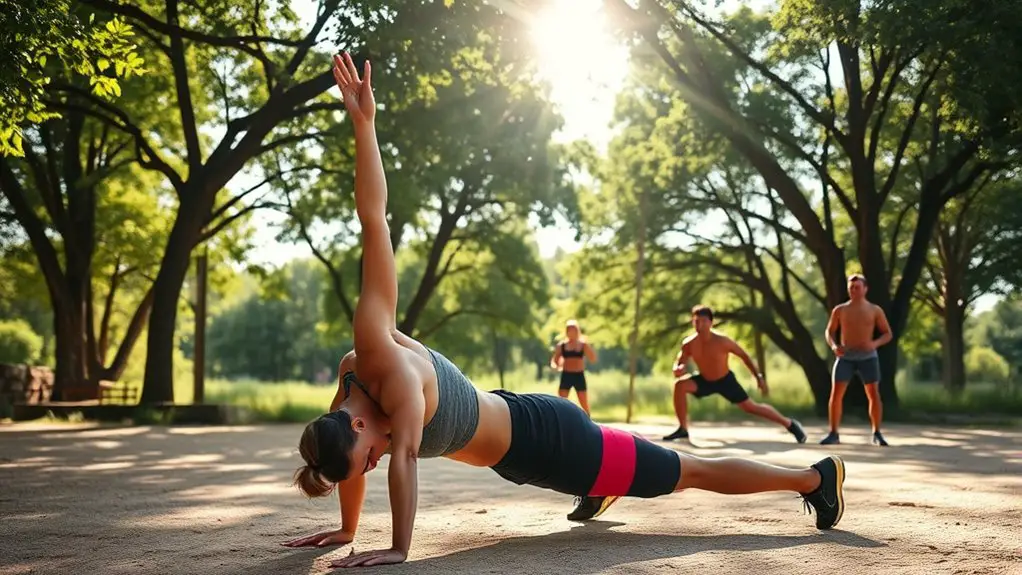To train for maximal power and strength in any sport, you should combine resistance training, plyometric exercises, and Olympic lifts. Focus on compound movements like squats and deadlifts to build strength. Incorporate plyometrics, like box jumps, to boost explosiveness. Olympic lifts enhance overall athleticism but guarantee technique is prioritized. Don't forget proper nutrition and hydration to support your efforts and recovery. There's so much more you can explore to optimize your training and achieve peak performance.
Understanding Power and Strength: The Fundamentals
Power and strength are two vital components of athletic performance, each playing a unique role in how you train and compete. Understanding power dynamics is essential, as it involves the ability to exert force quickly. This is significant in sports where speed and explosiveness matter. Strength principles, on the other hand, focus on building muscle and endurance, providing the foundation for all athletic movements.
When you grasp these fundamentals, you can design a training regimen that balances both elements, enhancing your overall performance. Think of power as the fuel that drives your explosiveness, while strength serves as the sturdy engine that supports sustained effort. By integrating these concepts, you'll reveal your potential and enjoy the freedom to excel in your sport. Embrace this journey, and you'll not only improve your skills but also experience the exhilarating satisfaction that comes with mastering your body's capabilities. Additionally, incorporating plyometric exercises into your routine can significantly enhance your explosiveness and agility.
The Importance of Resistance Training
To truly harness your potential in both power and strength, incorporating resistance training into your routine is key. This type of training not only builds muscle but also enhances your overall performance in any sport. By varying resistance types and adjusting your training frequency, you can reveal new levels of strength and power.
Here are some benefits of resistance training:
- Increased Muscle Mass: Promotes muscle growth, essential for strength.
- Enhanced Joint Stability: Improves joint integrity, reducing injury risk.
- Boosted Metabolism: Elevates calorie burn, even at rest.
- Improved Athletic Performance: Directly translates to better performance in your sport.
- Strength training exercises like squats and deadlifts can significantly enhance your overall power and stability.
Embrace resistance training, and you'll discover newfound freedom in your physical capabilities. It's about empowering yourself and breaking boundaries—so get started today!
Plyometric Exercises for Explosiveness
Incorporating plyometric exercises into your training can greatly enhance your explosiveness and overall athletic performance. By focusing on jump mechanics and explosive drills, you'll reveal your potential and experience the freedom of movement like never before. Plyometrics rely on the stretch-shortening cycle of muscles to maximize power output.
| Exercise | Benefits |
|---|---|
| Box Jumps | Builds power and speed |
| Depth Jumps | Improves reactive strength |
| Broad Jumps | Enhances horizontal explosiveness |
These exercises engage fast-twitch muscle fibers, giving you that extra push in your sport. Start with basic jump drills and progressively increase intensity. Remember, mastering proper jump mechanics is essential for safety and effectiveness. As you integrate these explosive drills, you'll not only feel stronger but also more agile, allowing you to break through physical barriers. Embrace the challenge, and watch your performance soar!
Incorporating Olympic Lifts Into Your Routine
After building your explosiveness with plyometric exercises, it's time to enhance your strength and power further through Olympic lifts. These lifts not only boost your overall athletic performance but also promote technique mastery, which is essential for efficiency and injury prevention. Here's how to incorporate them into your routine:
Elevate your strength and power with Olympic lifts, enhancing performance and mastering technique for injury prevention.
- Start with the basics: Focus on foundational movements like the clean, jerk, and snatch.
- Prioritize technique: Master each lift before adding weight; this guarantees proper form and reduces injury risk.
- Include accessory exercises: Work on related movements such as front squats and deadlifts to strengthen relevant muscle groups.
- Schedule wisely: Integrate Olympic lifts into your program 2-3 times a week, allowing for ample recovery. Additionally, consistent practice and analysis of movements are crucial for great technique.
The Role of Speed and Agility Training
While strength and power are essential for athletic performance, speed and agility are just as important for excelling in any sport. Integrating speed drills into your training routine can dramatically enhance your quickness and responsiveness on the field or court. These drills promote explosive movements, helping you get ahead of your competition.
Agility ladders are another fantastic tool for boosting your footwork and coordination. By incorporating ladder drills, you'll not only improve your agility but also build a solid foundation for balance and control. As you reveal these physical skills, you'll feel a newfound freedom in your movements, allowing you to react swiftly and decisively during games. Additionally, strength training enhances muscle power for directional changes, further improving your overall performance.
Nutrition for Optimal Performance
To maximize your power and strength, nutrition plays an essential role in fueling your body and supporting recovery. When you're pushing your limits, it's vital to focus on your macronutrient balance and hydration strategies to keep you at peak performance. Here are some tips to help you optimize your nutrition:
- Prioritize protein: Aim for high-quality sources to support muscle repair and growth.
- Incorporate healthy fats: They provide energy and support hormone production.
- Carbohydrate timing: Fuel up before workouts and replenish afterward to sustain energy levels.
- Stay hydrated: Drink plenty of water throughout the day and consider electrolyte-rich beverages during intense sessions. Additionally, ensuring adequate protein intake can significantly reduce soreness and accelerate recovery time.
Recovery Strategies to Enhance Strength Gains
Recovery is just as fundamental as training when it comes to enhancing your strength gains. To truly release your potential, you need to embrace effective recovery strategies. Start with active recovery; gentle activities like walking or yoga can boost blood flow, helping your muscles heal faster.
Next, prioritize sleep optimization. Quality sleep not only aids in muscle recovery but also supports hormone production, essential for strength gains. Aim for 7-9 hours of restorative sleep each night, and create a calming bedtime routine to enhance the quality of your rest. Additionally, remember that quality sleep is vital for enhancing cognitive function and improving decision-making, both of which are crucial for athletic performance.
Consider incorporating techniques like foam rolling or stretching to alleviate muscle tension and improve flexibility. Hydration plays a significant role too, so keep your water intake high. By balancing intense workouts with these recovery strategies, you'll experience the freedom to push your limits while ensuring your body is primed for strength development. Embrace recovery, and watch your gains soar!
Frequently Asked Questions
How Long Does It Take to See Strength Gains?
Think of your strength journey as a seed planted in fertile soil; with care, it'll flourish. You'll start to see strength gains in about 4 to 6 weeks, but it depends on your training frequency and consistency. As you nourish your body with the right workouts, each session becomes a step toward greater freedom and power. Embrace the process, trust in your progression, and watch as your potential unfolds beautifully over time.
Can I Train for Power Without a Gym?
Absolutely, you can train for power without a gym! Bodyweight exercises like push-ups, squats, and explosive jumps are perfect for building strength and power. Plus, outdoor workouts let you enjoy nature while getting fit. You don't need fancy equipment; just your body and some space. Mix in sprinting or agility drills, and you'll see improvements in your power. Embrace the freedom of training anywhere, anytime, and release your potential!
What Are Common Mistakes in Power Training?
Imagine you're pushing through a heavy lift, but your form's all over the place—this is a classic example of technique errors in power training. You might think you're making gains, but without proper technique, you're risking injury. Plus, don't neglect recovery; it's just as essential as your workouts. If you don't let your body rest and repair, you'll hinder your progress and limit your freedom to perform at your best.
How Do I Stay Motivated During Training?
Staying motivated during training can be tough, but setting clear goals can help. Break your larger goals into smaller, achievable milestones to celebrate progress. Remember, mental resilience is key; it'll help you push through tough days. Embrace the freedom of your journey, focusing on the joy of improvement rather than just the end result. Surround yourself with supportive people and keep reminding yourself why you started. You've got this!
Is It Safe to Train for Strength Every Day?
Training for strength every day isn't generally recommended. Your muscles need time to recover, and daily training can lead to overuse injuries. Instead, consider a balanced approach that incorporates recovery methods like rest days, stretching, or active recovery. This way, you can keep your freedom to train while ensuring your body stays strong and healthy. Listen to your body; it'll tell you when it's time to push harder or take a break.




